Table of Contents
Chicken is one of the most popular foods in the world. From soups and curries to grilled and roasted dishes, it is loved for its taste, versatility, and affordability. But apart from being delicious, chicken is also packed with nutrients that our body needs to stay healthy.
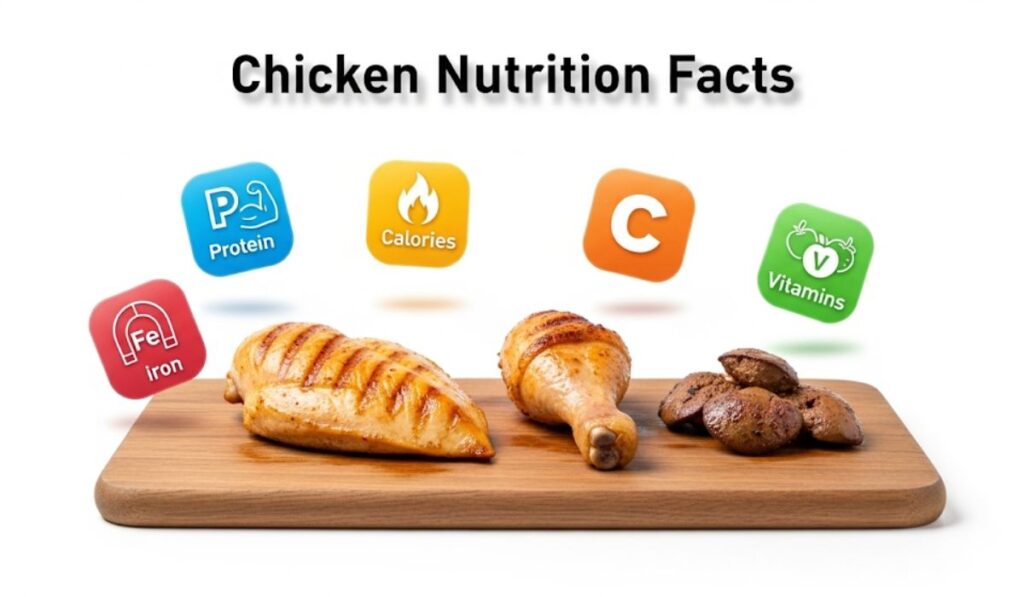
In this article, we will explore the nutritional content of chicken, focusing on different parts such as chicken breast, drumstick, and liver. We will also look at the calorie content, protein content, vitamins, minerals, and the overall benefits of including chicken in your diet.
Why Chicken Is Considered a Healthy Meat
Chicken is often called a lean protein source. This means it provides high-quality protein with relatively low fat, especially when compared to red meats like beef or lamb. Protein is important for building muscles, repairing tissues, and keeping your immune system strong.
Moreover, chicken is rich in important minerals such as iron, zinc, and phosphorus, and it also contains B vitamins that support energy production and brain health.
Nutritional Content of Chicken (General Overview)
The nutrition in chicken depends on the cut (breast, drumstick, thigh, or liver) and how it is cooked (grilled, boiled, fried, or roasted). Here’s an approximate breakdown of nutrients in 100 grams of cooked chicken meat (skinless, roasted):
- Calories: 165 kcal
- Protein: 31 g
- Fat: 3.6 g
- Carbohydrates: 0 g
- Iron: 0.9 mg
- Vitamin B6: 0.6 mg
- Phosphorus: 223 mg
- Zinc: 1 mg
Nutritional Comparison of Chicken Parts (per 100 g, cooked, skinless)
| Chicken Part | Calories | Protein (g) | Fat (g) | Iron (mg) | Key Benefit |
|---|---|---|---|---|---|
| Chicken Breast | 165 | 31 | 3.6 | 0.7 | Lean, high protein |
| Chicken Drumstick | 185 | 28 | 5.2 | 1.1 | Good protein + iron |
| Chicken Thigh | 209 | 26 | 8.0 | 1.3 | Juicier, more flavor |
| Chicken Liver | 167 | 25 | 6.0 | 9.0 | High iron + vitamin A |
This makes chicken an excellent source of protein with very little carbohydrate and moderate fat.
Chicken Breast Nutritional Value
The chicken breast is the leanest part of the bird, meaning it has very little fat but a lot of protein. This is why athletes, bodybuilders, and people trying to lose weight often prefer chicken breast.
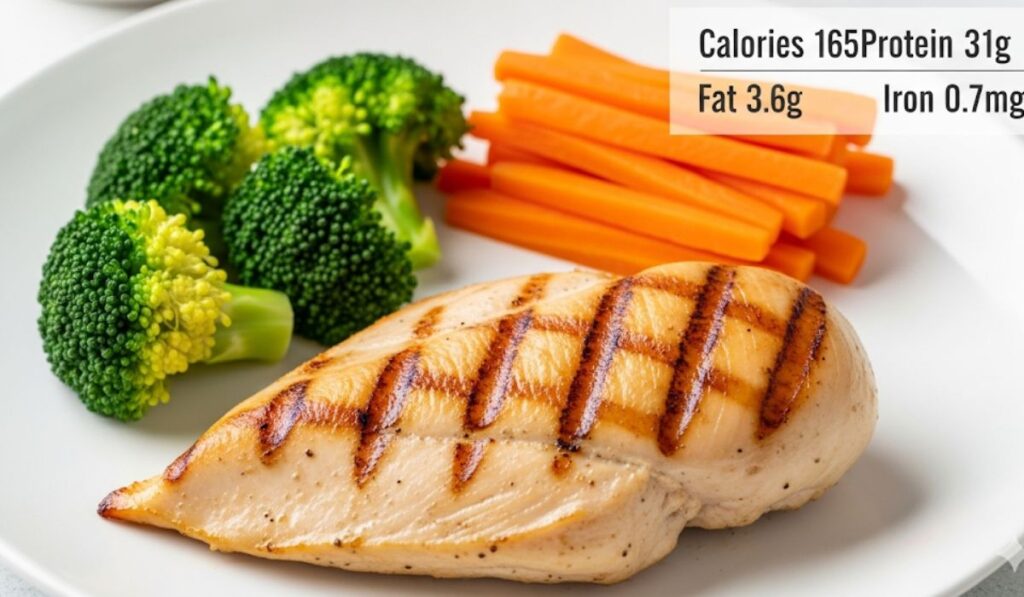
Nutritional information for 100 g of chicken breast (skinless, cooked):
- Calories: 165 kcal
- Protein content: 31 g
- Fat content: 3.6 g
- Iron content: 0.7 mg
👉 Key takeaway: Chicken breast is the best option if you want high protein with low fat and fewer calories.
Chicken Drumstick Nutritional Value
The chicken drumstick (leg portion) has a bit more fat than the breast, but it also offers extra flavor.
Nutritional information for 100 g of cooked chicken drumstick (skinless):
- Calories: 185 kcal
- Protein: 28 g
- Fat: 5.2 g
- Iron: 1.1 mg
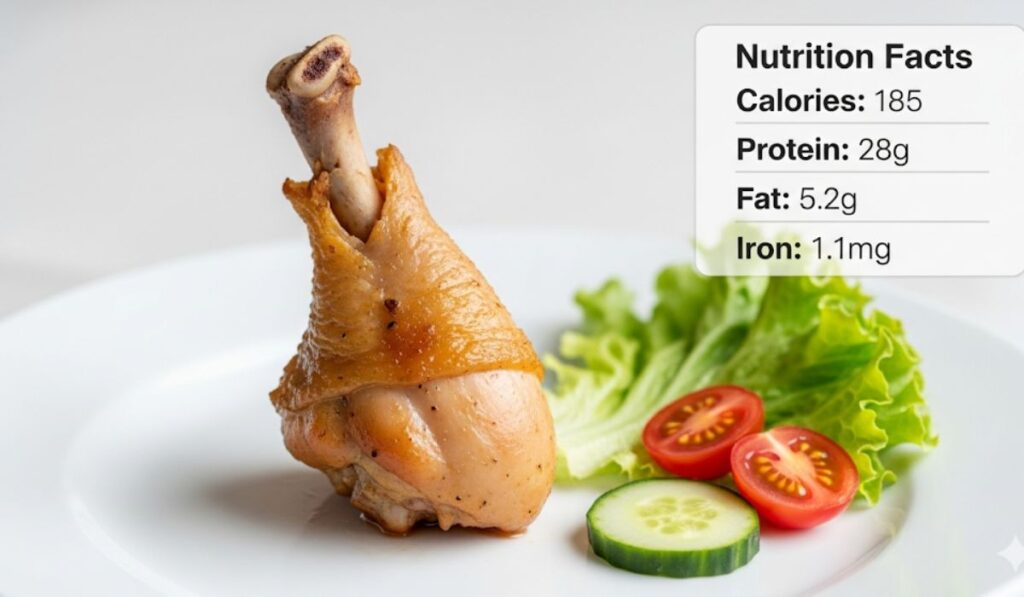
👉 Key takeaway: Drumsticks are slightly higher in fat and calories compared to chicken breast but still provide a good amount of protein and iron.
Chicken Thigh vs Chicken Drumstick
Many people confuse the thigh and drumstick. Both are from the leg but differ slightly:
- Chicken thigh has more fat and is juicier.
- Chicken drumstick has a balance of protein and moderate fat.
Both are nutritious, but if you want more flavor, thighs and drumsticks are better.
Chicken Liver Nutritional Value
While most people eat chicken breast or legs, the chicken liver is one of the most nutrient-dense parts. It is especially rich in iron and vitamins.
Nutritional information for 100 g of chicken liver (cooked):
- Calories: 167 kcal
- Protein content: 25 g
- Fat content: 6 g
- Iron content: 9 mg
- Vitamin A: 11,000 IU
- Folate: 560 mcg
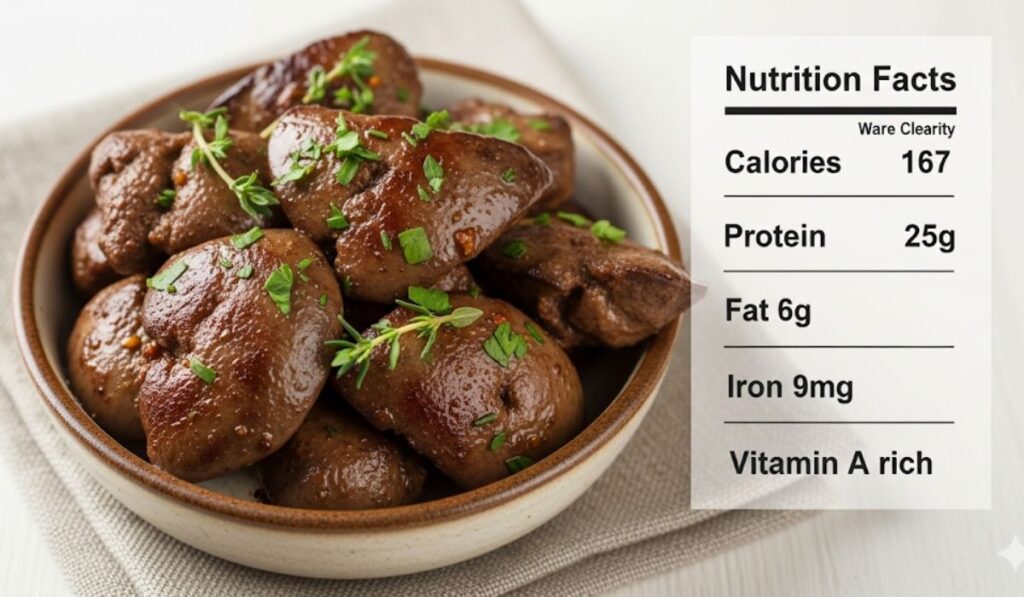
👉 Key takeaway: Chicken liver is one of the best natural sources of iron and vitamin A, making it great for preventing anemia and supporting eye health.
Protein Content in Chicken
Protein is one of the most important nutrients in chicken. Here’s a quick look at how much protein different chicken parts provide (per 100 g, cooked, skinless):
- Chicken breast: 31 g
- Chicken drumstick: 28 g
- Chicken thigh: 26 g
- Chicken liver: 25 g
👉 Key takeaway: All parts of chicken are rich in protein, but chicken breast has the highest protein content with the least fat.
Fat Content in Chicken
Fat levels in chicken vary depending on the cut and whether the skin is eaten. Most of the fat is under the skin, so removing it reduces calories.
- Chicken breast: 3.6 g fat
- Chicken drumstick: 5.2 g fat
- Chicken thigh: 8 g fat
- Chicken liver: 6 g fat
👉 Key takeaway: If you want low fat, go for chicken breast. If you want taste and don’t mind extra fat, thighs and drumsticks are fine.
Iron Content in Chicken
Iron is important for making red blood cells and preventing fatigue. Chicken provides heme iron, which is easily absorbed by the body (better than iron from plants).
- Chicken breast: 0.7 mg iron
- Chicken drumstick: 1.1 mg iron
- Chicken liver: 9 mg iron
👉 Key takeaway: Chicken liver is a superfood for iron, making it excellent for people with anemia or low energy.
Vitamins and Minerals in Chicken
Chicken is not just about protein—it is also rich in essential vitamins and minerals:
- Vitamin B6 & B12: Support energy and brain function.
- Niacin (Vitamin B3): Helps in metabolism.
- Vitamin A (from liver): Supports vision and immunity.
- Phosphorus: Good for bones and teeth.
- Zinc: Boosts immunity.
- Selenium: Powerful antioxidant that protects cells.
Vitamins & Minerals in Chicken
| Nutrient | Function in Body | Best Source (Chicken Part) |
|---|---|---|
| Vitamin B6 | Supports brain health, metabolism | Breast, thigh |
| Vitamin B12 | Makes red blood cells, boosts energy | Drumstick, liver |
| Vitamin A | Improves vision & immunity | Liver |
| Iron | Prevents fatigue & anemia | Liver, drumstick |
| Phosphorus | Strengthens bones & teeth | Breast, thigh |
| Zinc | Boosts immunity & healing | Drumstick, liver |
| Selenium | Protects cells from damage | Breast, thigh |
How Cooking Methods Affect Nutrition
The way you cook chicken can change its nutritional value:
- Grilled or boiled: Keeps it lean and healthy.
- Fried chicken: Adds extra fat and calories.
- Roasted chicken: Balanced, flavorful, and still nutritious.
👉 For the healthiest option, go for grilled, boiled, or baked chicken without skin.
Benefits of Eating Chicken
- Muscle growth – High protein supports strong muscles.
- Weight management – Low in calories, especially breast meat.
- Boosts immunity – Rich in zinc, selenium, and vitamins.
- Improves energy – Iron and B vitamins help fight tiredness.
- Supports healthy skin and eyes – Thanks to vitamin A from chicken liver.
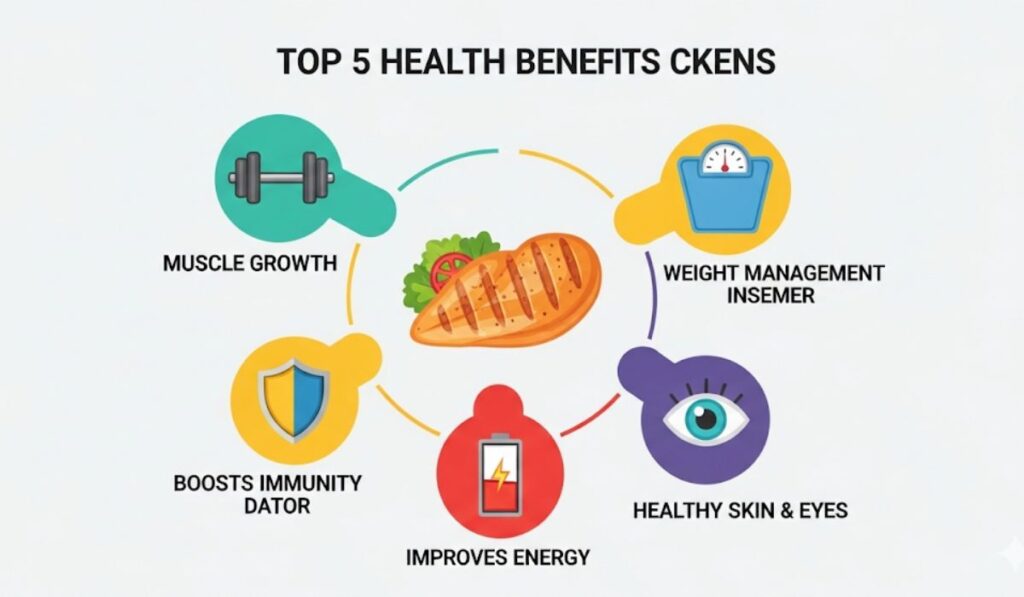
Things to Keep in Mind
- Avoid too much fried or processed chicken (like nuggets and sausages), as they are high in unhealthy fats and sodium.
- Always cook chicken properly to avoid infections like salmonella.
- Balance chicken with vegetables, fruits, and whole grains for a healthy diet.
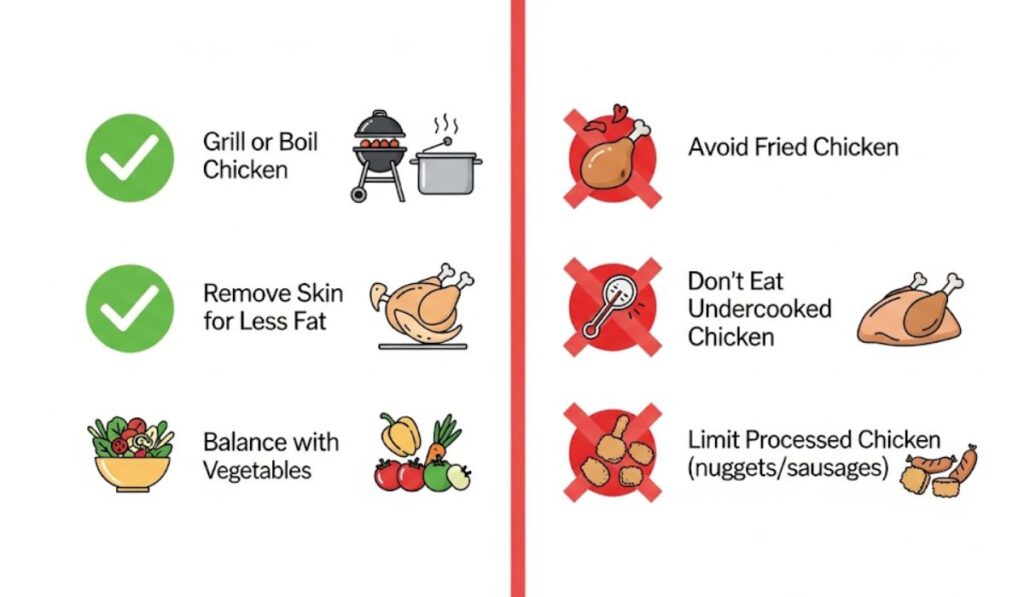
Conclusion
Chicken is a nutrient-rich and versatile meat that provides an excellent balance of protein, vitamins, and minerals. Whether you prefer chicken breast for lean protein, drumsticks for taste, or chicken liver for iron and vitamin A, there is something healthy in every part of the bird.
By choosing the right cut and cooking method, chicken can be a regular part of a balanced and nutritious diet.
Frequently Asked Questions (FAQs)
1. What is the nutritional content of chicken?
Chicken is high in protein and low in carbohydrates. On average, 100 g of cooked chicken provides about 165 calories, 31 g protein, and 3–5 g fat, along with important minerals like iron, zinc, and phosphorus.
2. How many calories are in chicken breast?
A 100 g serving of cooked, skinless chicken breast has about 165 calories. It is one of the leanest parts of the chicken, making it a favorite for weight loss and fitness diets.
3. How much protein does chicken breast contain?
Chicken breast is rich in protein, with around 31 g per 100 g serving. It is considered the best choice for building muscle and maintaining a lean body.
4. What is the nutritional value of chicken drumsticks?
Chicken drumsticks provide about 185 calories, 28 g protein, and 5 g fat per 100 g. They are slightly higher in fat compared to chicken breast but are also rich in iron and flavor.
5. Is chicken high in fat?
Chicken is relatively low in fat, especially when eaten without the skin. The fat content depends on the cut:
- Breast: ~3.6 g fat (leanest)
- Drumstick: ~5 g fat
- Thigh: ~8 g fat
- Liver: ~6 g fat
6. Does chicken contain iron?
Yes, chicken is a good source of heme iron, which is easily absorbed by the body. Chicken breast has about 0.7 mg, drumsticks have 1.1 mg, and chicken liver has a very high 9 mg of iron per 100 g.
7. What are the benefits of eating chicken liver?
Chicken liver is packed with protein, iron, vitamin A, and folate. It supports healthy blood, strong immunity, and good eyesight. However, it should be eaten in moderation because of its high vitamin A content.
8. Is chicken good for weight loss?
Yes. Chicken, especially skinless chicken breast, is low in calories and fat but very high in protein, making it excellent for weight loss food as drinks as soup.
9. How should chicken be cooked for maximum nutrition?
For the healthiest results, choose grilled, boiled, roasted, or baked chicken without skin. Avoid deep frying, as it adds extra fat and calories.
10. Which part of the chicken is the healthiest?
- Best for protein & low fat: Chicken breast
- Best for iron & vitamins: Chicken liver
- Best for flavor: Chicken thighs and drumsticks


